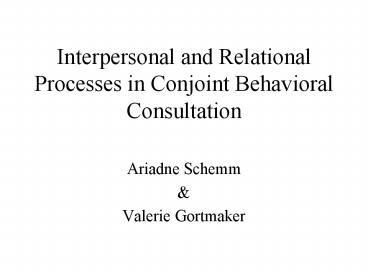Interpersonal and Relational Processes in Conjoint Behavioral Consultation - PowerPoint PPT Presentation
Title:
Interpersonal and Relational Processes in Conjoint Behavioral Consultation
Description:
Positive Communication Emphasize the positive and realistic aspects of the child (e.g., good news phone calls). Conflict Management Focus on Mutual Goals Use ... – PowerPoint PPT presentation
Number of Views:121
Avg rating:3.0/5.0
Title: Interpersonal and Relational Processes in Conjoint Behavioral Consultation
1
Interpersonal and Relational Processes in
Conjoint Behavioral Consultation
- Ariadne Schemm
- Valerie Gortmaker
2
Development of Relationship-Building Competencies
in Consultees
- Overt Didactic Approach
- Role Model
- Practice
- Feedback
3
Training Interpersonal Skills
4
Skill Domains
- Microskills
- Perspective Taking
- Building Partnerships
- Conflict Management
5
Microskills
- Open Questions
- Minimal Encouragers
- Reflection
- Self-disclosure
- Paraphrase/Summarize
6
Open Questions
- Questions that are designed to elicit more than a
single response (they open the opportunity for
the client to talk, elaborate, and/or describe
situations) - Video Clip
7
Minimal Encouragers
- Statements or gestures that encourage the
consultee to communicate their thoughts or ideas
(e.g., um hum, huh or head nods).
8
Reflection
- A statement made by the consultant that responds
to the emotional tone of the consultees message.
9
Self-Disclosure
- Personal experiences of the consultant shared
with the consultee within the consultative
relationship.
10
Paraphrase
- Paraphrase A statement that rephrases the
content of the consultees message (i.e.,
describing a situation, event, person, or idea)
using ones own language. - Video Clip
11
Summarize
- Summarize A statement that combines two or more
paraphrases and condenses the essential elements
of the consultees message.
12
Perspective Taking
- Listen to and Acknowledge Different Perspectives
- Adopt a Non-deficit Approach
- Be Responsive
13
Listen to and Acknowledge Different Perspectives
- Help the consultees see that the situation can be
viewed from different vantage points, and that
this can be beneficial for problem-solving. - Video Clip
14
Adopt a Non-deficit Approach
- Place attention on the shared strengths of the
home, school and child, rather than on efforts to
fix child, family or school problems. - Video Clip
15
Be Responsive
- Attend to consultees needs and provide effective
resources.
16
Building Partnerships
- Point out Similar Experiences
- Point out Consultee Contributions
- Develop Opportunities for Positive Communication
17
Point out Similar Experiences
- Highlight the similarity of examples provided by
the parents and teachers.
18
Point out Consultee Contributions
- Recognize the benefits associated with the unique
contributions of parents and educators.
19
Positive Communication
- Emphasize the positive and realistic aspects of
the child (e.g., good news phone calls).
20
Conflict Management
- Focus on Mutual Goals
- Use Language to Unify (e.g., us, we, our)
- Reframing
- Provide Structure
- Read Nonverbal Language
21
Focus on Mutual Goals
- Place an emphasis on the situation and concerns
shared across systems, not the individual parent,
teacher or student.
22
Use Language to Unify
- Emphasize a team concept with words such as we,
us, and together.
23
Reframing
- Re-name or re-label a consultees thoughts,
feelings, or beliefs about a particular
individual, situation, or process to provide an
alternate positive frame of reference.
24
Provide Structure
- Use the structured problem solving steps to
systematically resolve the issue.
25
Read Nonverbal Language
- Be attentive to the consultees nonverbal cues.
26
- Interpersonal skills are the keys to bringing
systems together in a supportive and
collaborative manner. - Didactic supervision presents interpersonal
skills as a vehicle to build home-school
partnerships. - Role playing and role-modeling provide
interpersonal practice to facilitate individual
development. - On-site practicum provides training and feedback
experience in real-life situations.
27
The Effect of Good Interpersonal Skills
- Interpersonal skills are the roots upon which one
needs to build the more systemic goals to
ultimately meet the needs of the child. - Build awareness of interpersonal skills through
building competencies. - Once competencies are built, consultants use
skills to ultimately meet more systemic goals of
providing home-school partnerships and focusing
on family needs.































